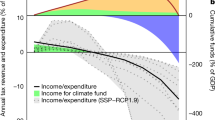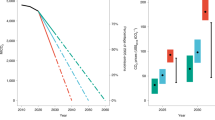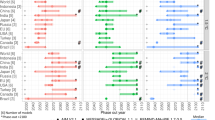Abstract
Negative emissions technologies are attracting the interest of investors in the race to make them effective and profitable. When deployed at scale, they will be financed through public funds, reducing the fiscal space for a socially inclusive climate transition. Moreover, if the private sector owns negative emissions technologies, potentially large profits would disproportionally benefit investors and equity holders. Here we quantify the inequality repercussions of direct air capture of CO2 in a 1.5 °C scenario, using a regional integrated assessment model that features within-country income heterogeneity. We find that, under a single carbon market, financing negative emissions technologies could double the increase in income inequality of climate policy. The effects are highest around the time of net zero and in scenarios with carbon budget overshoot. We identify the drivers of the inequality increase and discuss policy provisions to mitigate the equity concerns of CO2 removal strategies.
This is a preview of subscription content, access via your institution
Access options
Access Nature and 54 other Nature Portfolio journals
Get Nature+, our best-value online-access subscription
$29.99 / 30 days
cancel any time
Subscribe to this journal
Receive 12 print issues and online access
$209.00 per year
only $17.42 per issue
Buy this article
- Purchase on Springer Link
- Instant access to full article PDF
Prices may be subject to local taxes which are calculated during checkout





Similar content being viewed by others
Data availability
All scenario runs and code used to produce the figures and data analysis are available in open source at https://doi.org/10.5281/zenodo.8397488.
Code availability
The model used to produce the scenarios is available in open source at https://github.com/witch-team/RICE50xmodel. To run the model, an active GAMS licence with CONOPT3 is required.
References
Rathi, A. Stripe, Alphabet and others to spend nearly $1 billion on carbon removal. BNN Bloomberg www.bnnbloomberg.ca/stripe-alphabet-and-others-to-spend-nearly-1-billion-on-carbon-removal-1.1751098 (2022).
IPCC Climate Change 2022: Mitigation of Climate Change (eds Shukla, P. R. et al.) (Cambridge Univ. Press, 2022).
Fuss, S. et al. Negative emissions—part 2: costs, potentials and side effects. Environ. Res. Lett. 13, 063002 (2018).
Smith, P. et al. Biophysical and economic limits to negative CO2 emissions. Nat. Clim. Change 6, 42–50 (2016).
McLaren, D. Quantifying the potential scale of mitigation deterrence from greenhouse gas removal techniques. Climatic Change 162, 2411–2428 (2020).
Grant, N., Hawkes, A., Mittal, S. & Gambhir, A. Confronting mitigation deterrence in low-carbon scenarios. Environ. Res. Lett. 16, 064099 (2021).
Markusson, N., McLaren, D. & Tyfield, D. Towards a cultural political economy of mitigation deterrence by negative emissions technologies (NETs). Glob. Sustain. 1, e10 (2018).
Rickels, W., Proelß, A., Geden, O., Burhenne, J. & Fridahl, M. Integrating carbon dioxide removal into European emissions trading. Front. Clim. https://doi.org/10.3389/fclim.2021.690023 (2021).
IPCC: Summary for Policymakers. In Climate Change 2022: Mitigation of Climate Change (eds Shukla, P. R. et al.) (Cambridge Univ. Press, 2022).
Bednar, J. et al. Operationalizing the net-negative carbon economy. Nature 596, 377–383 (2021).
Bednar, J., Obersteiner, M. & Wagner, F. On the financial viability of negative emissions. Nat. Commun. 10, 1783 (2019).
Budolfson, M. et al. Climate action with revenue recycling has benefits for poverty, inequality and well-being. Nat. Clim. Change 11, 1111–1116 (2021).
Steckel, J. C. et al. Distributional impacts of carbon pricing in developing Asia. Nat. Sustain 4, 1005–1014 (2021).
Ohlendorf, N., Jakob, M., Minx, J. C., Schröder, C. & Steckel, J. C. Distributional impacts of carbon pricing: a meta-analysis. Environ. Resour. Econ. 78, 1–42 (2021).
Pozo, C., Galán-Martín, Á., Reiner, D. M., Mac Dowell, N. & Guillén-Gosálbez, G. Equity in allocating carbon dioxide removal quotas. Nat. Clim. Change 10, 640–646 (2020).
Lee, K. S. B., Fyson, C. & Schleussner, C.-F. Fair distributions of carbon dioxide removal obligations and implications for effective national net-zero targets. Environ. Res. Lett. https://doi.org/10.1088/1748-9326/ac1970 (2021).
Fyson, C. L., Baur, S., Gidden, M. & Schleussner, C.-F. Fair-share carbon dioxide removal increases major emitter responsibility. Nat. Clim. Change 10, 836–841 (2020).
Gazzotti, P. et al. Persistent inequality in economically optimal climate policies. Nat. Commun. https://doi.org/10.1038/s41467-021-23613-y (2021).
Dennig, F., Budolfson, M. B., Fleurbaey, M., Siebert, A. & Socolow, R. H. Inequality, climate impacts on the future poor, and carbon prices. Proc. Natl Acad. Sci. USA 112, 15827–15832 (2015).
Minx, J. et al. Negative emissions—part 1: research landscape and synthesis. Environ. Res. Lett. 13, 063001 (2018).
Semieniuk, G. et al. Stranded fossil-fuel assets translate to major losses for investors in advanced economies. Nat. Clim. Change 12, 532–538 (2022).
Semieniuk, G. et al. Potential pension fund losses should not deter high-income countries from bold climate action. Joule 7, 1383–1387 (2023).
Drouet, L. et al. Net zero-emission pathways reduce the physical and economic risks of climate change. Nat. Clim. Change 11, 1070–1076 (2021).
Riahi, K. et al. Cost and attainability of meeting stringent climate targets without overshoot. Nat. Clim. Change 11, 1063–1069 (2021).
Berger, L. & Emmerling, J. Welfare as equity equivalents. J. Econ. Surv. 34, 727–752 (2020).
Riahi, K. et al. The Shared Socioeconomic Pathways and their energy, land use, and greenhouse gas emissions implications: an overview. Glob. Environ. Change 42, 153–168 (2017).
Gazzotti, P. RICE50+: DICE model at country and regional level. Socio-Environ. Syst. Model. 4, 18038 (2022).
Rao, N. D., Sauer, P., Gidden, M. & Riahi, K. Income inequality projections for the shared socioeconomic pathways (SSPs). Futures 105, 27–39 (2019).
Emmerling, J. et al. Global inequality consequences of climate policies when accounting for avoided climate impacts. Cell Rep. Sustain. (in the press).
Realmonte, G. et al. An inter-model assessment of the role of direct air capture in deep mitigation pathways. Nat. Commun. 10, 3277 (2019).
Shayegh, S., Bosetti, V. & Tavoni, M. Future prospects of direct air capture technologies: insights from an expert elicitation survey. Front. Clim. https://doi.org/10.3389/fclim.2021.630893 (2021).
Acknowledgements
The authors have received no external funding for this work.
Author information
Authors and Affiliations
Contributions
All the authors designed and conceptualized the research questions and scenarios. P.A. and J.E. performed the model advancements. P.A. ran the scenarios, analysed the data and produced the figures. P.A. and M.T. wrote the first draft. All the authors extensively contributed to the final version of the paper.
Corresponding author
Ethics declarations
Competing interests
The authors declare no competing interests.
Peer review
Peer review information
Nature Climate Change thanks Carl-Friedrich Schleussner and the other, anonymous, reviewer(s) for their contribution to the peer review of this work.
Additional information
Publisher’s note Springer Nature remains neutral with regard to jurisdictional claims in published maps and institutional affiliations.
Extended data
Extended Data Fig. 1 Calibration of income taxes and wealth elasticities.
Income taxes elasticities (red) and wealth-to-income elasticity (blue) for each year between 2000 and 2020. Boxplots highlight median, 25th and 75th percentiles, points represent outliers. The number of observations and the median of the values is highlighted in text for each year.
Supplementary information
Supplementary Information
Supplementary Annexes A–L.
Rights and permissions
Springer Nature or its licensor (e.g. a society or other partner) holds exclusive rights to this article under a publishing agreement with the author(s) or other rightsholder(s); author self-archiving of the accepted manuscript version of this article is solely governed by the terms of such publishing agreement and applicable law.
About this article
Cite this article
Andreoni, P., Emmerling, J. & Tavoni, M. Inequality repercussions of financing negative emissions. Nat. Clim. Chang. 14, 48–54 (2024). https://doi.org/10.1038/s41558-023-01870-7
Received:
Accepted:
Published:
Issue Date:
DOI: https://doi.org/10.1038/s41558-023-01870-7



